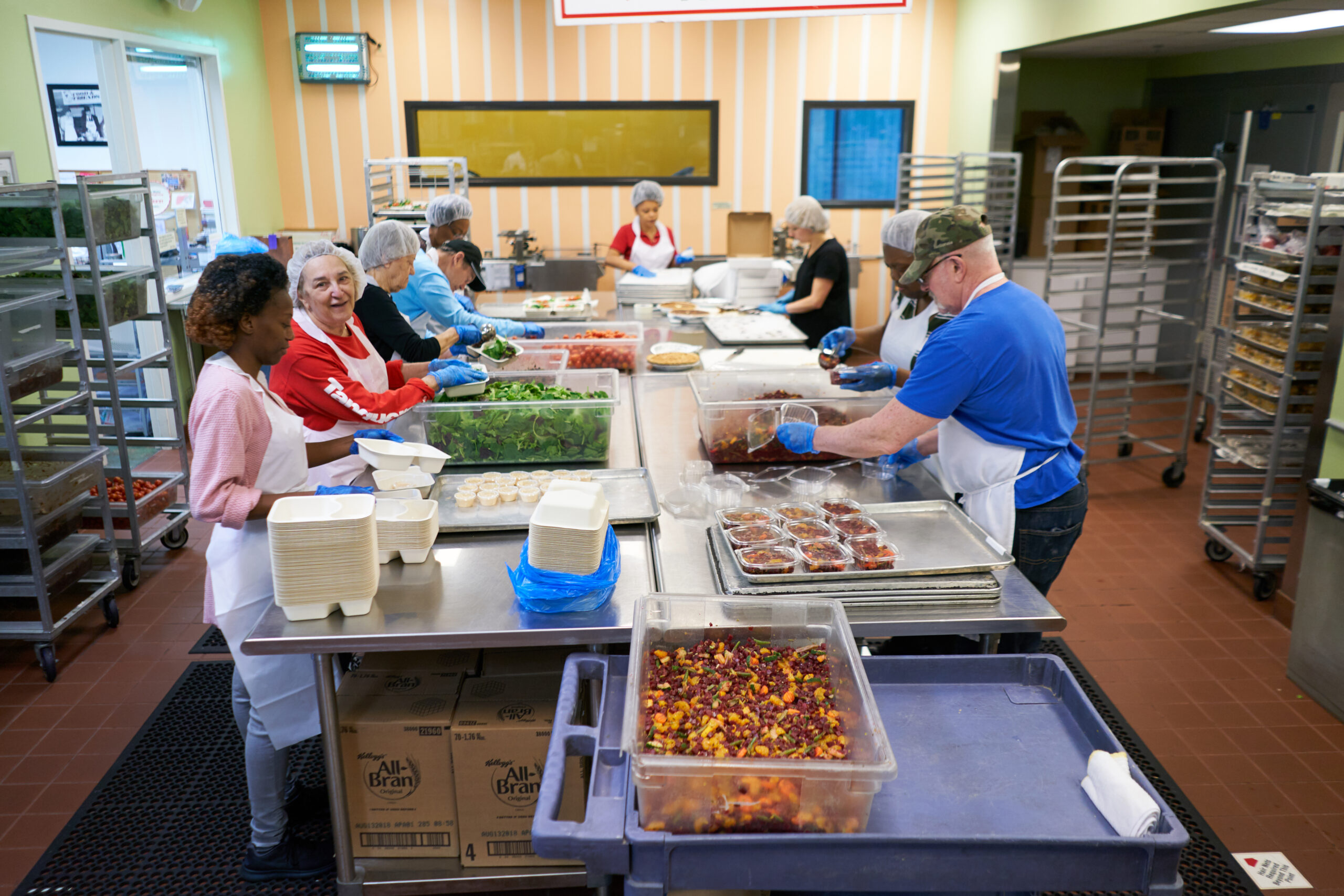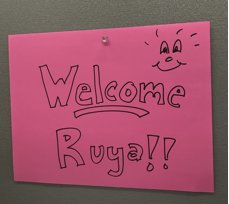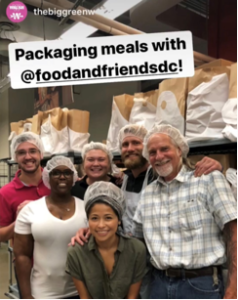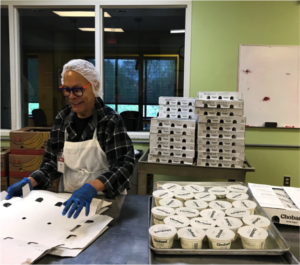
 Hello folks! My name is Ruya Norton and I am the newest addition to the Food & Friends team, joining our Development Department in the role of Digital Marketing and Fundraising Manager. As is custom for all Food & Friends staff, I spent my first week in “boot camp,” an onboarding process that involves one-on-one meetings, volunteer shifts and various other orientations. Boot camp gives new employees the opportunity to see and experience Food & Friends holistically rather than solely through the lens of their assigned office. If you’ve ever wondered what happens at Food & Friends, taking part as a volunteer will offer you more than just a glimpse. You’ll be one of the nearly nine thousand annual volunteers who enable Food & Friends to function and thrive year-round. More importantly, you’ll meet friends and neighbors overflowing with compassion and generosity. Here are some of the interactions that have stayed with me during my boot camp volunteer shifts.
Hello folks! My name is Ruya Norton and I am the newest addition to the Food & Friends team, joining our Development Department in the role of Digital Marketing and Fundraising Manager. As is custom for all Food & Friends staff, I spent my first week in “boot camp,” an onboarding process that involves one-on-one meetings, volunteer shifts and various other orientations. Boot camp gives new employees the opportunity to see and experience Food & Friends holistically rather than solely through the lens of their assigned office. If you’ve ever wondered what happens at Food & Friends, taking part as a volunteer will offer you more than just a glimpse. You’ll be one of the nearly nine thousand annual volunteers who enable Food & Friends to function and thrive year-round. More importantly, you’ll meet friends and neighbors overflowing with compassion and generosity. Here are some of the interactions that have stayed with me during my boot camp volunteer shifts.
 Groceries-to-Go Shift
Groceries-to-Go Shift
My first volunteer shift was with Groceries-to-Go (GTG), a program that serves clients in the outer-most reaches of our 5,300 square mile service area. Through GTG, Food & Friends supports individuals who live beyond Home-Delivered Meals (HDM) range, but who are still in need of nutritious food. These individuals tend to have a caregiver or family member who can cook the ingredients your support helps provide.
During my GTG shift, I had the pleasure of working alongside employees from the Walsh Group (pictured left), as well as GTG Assistant, Leonard Caldwell. Long-time donor, Joan Palmer-Sizemore, also packed grocery bags with us. Having volunteered in virtually every capacity at Food & Friends, Joan shared her expansive knowledge of the organization while doling out helpful tips and instructions. The shift went by in a flash, due in no small part to the joy and enthusiasm that surrounded me.
Delivery Shift
On the morning of my delivery shift, I paired up with staff delivery driver, Ronika Barnes, and assisted her in locating carts to transport specially tailored meal bags from the refrigerator to her van, verifying orders and reviewing driving routes. We would be delivering groceries and meals to clients in Maryland for the next eight hours, so driving in a refrigerated van was a necessity (thank you for helping us purchase a new one!). After locating a couple of specialty items – including a client birthday cake (something Chef Tim prepares for all of our clients on their birthday) – we packed up the van and embarked. This was one of more than 270 delivery routes Food & Friends staff and volunteers drive each week.
Our first destination was a drop-off spot in Forestville, where we met Neighborhood Distribution Partners (NDP) and transferred bags of food from the van to the NDP cars. Next, we weaved through neighborhoods between Oxon Hill and Fort Washington, bringing meals directly to each client’s home. As the designated “jumper,” I met family members, caregivers, and clients at their doors, a unique and beautiful aspect of the Food & Friends delivery model. Connecting with clients face-to-face allows Food & Friends the opportunity to monitor their health while building trust, mutual respect and – you guessed it – friendship. I quickly noticed how grateful each person was, not only for the food but also for the companionship. Some clients wanted to chat, while others told me to “take care” or “be safe” with a hint of concern in their voices. After all, this was an autumn day that could fool any area resident for a summer scorcher. It dawned on me that we were delivering meals to individuals with life-challenging illnesses – limiting their finances, their plans, their futures – and they were worried about us. This is where the mission of Food & Friends really comes full circle. We’re not only delivering food, we’re also delivering friendship, which is returned to us in abundance.
 Kitchen Shift
Kitchen Shift
It’s hard to say which volunteer shift was my favorite during boot camp, as they were all different and valuable in their own right. But, working in the kitchen was probably the most heart-warming. I joined a group of volunteers made up of veteran supporters as well as newer friends to the organization. One of my teammates started volunteering in the early days of Food & Friends, at the height of the AIDS epidemic. He knew people who went from active community members to sick and isolated, suffering from and managing their illness alone. Another volunteer, Patrick Hamilton, visits the “Memorial Board” – a place where recently deceased clients are honored – every time he steps foot in the Food & Friends building. Patrick said he prays for all of them and opened up his phone to reveal a photo album almost entirely made up of these names – he saves and carries them with him. The magnitude of Patrick’s commitment to caring for and loving his neighbors took me by surprise, and I stood still for a moment in awe.
Long-time volunteer, Betty (pictured right), did not have a personal connection to the AIDS epidemic, but when she learned about Food & Friends years ago, she jumped at the opportunity to help her neighbors in need. Now, she’s a regular presence in the kitchen.
On this particular shift, we portioned English muffins, separated bananas from the bunch and ladled egg drop soup into containers. What might be considered mundane or monotonous was anything but. With music bopping, laughter bellowing and conversation filling the space, my kitchen shift was fun and fast-paced.
Expediting Shift
Expediting was the most eye-opening shift in terms of understanding just how organized Food & Friends needs to be in order to efficiently sort and deliver eleven meal plans to thousands of clients every day. Damali Allen, Expediting Assistant, explained the packing instructions, meal plans, color codes (ex: light green stands for GI friendly), and the use of multiple colors to denote meals with more than one variant (ex: red and pink indicates a heart-healthy and soft meal). Food & Friends clients can have up to three combinations for their specialized meals, so precision and attention to detail are crucial to successfully packing a delivery bag. My teammates and I worked to ensure accuracy, double and triple-checking orders as we went.
As the final step before delivery, it was especially gratifying to envision a recipient at the end of the day, sitting down with a meal we were assembling. Our Executive Director, Carrie Stoltzfus, often cites this imagery as her daily motivation and I now understand why. Regardless of the role you play at Food & Friends – whether donor, volunteer or staff – your contribution ensures that thousands of neighbors in need have healthy food to eat. This is the very definition of community. We’re united for a cause and rely on one another to get the job done.
Boot camp has officially concluded for me, but that doesn’t mean I’ll be far from the action. Earlier this week, in fact, I filled in for an expediting shift that needed extra help. Thanksgiving is another opportunity for staff outside of the kitchen to engage in the “bread and butter” (pardon the pun) execution of our mission, taking on an array of responsibilities shoulder-to-shoulder with volunteers. This all-hands approach to “getting the job done” is unlike anything I’ve witnessed in my nonprofit career and it perfectly illustrates the Food & Friends culture of compassion. If you’ve spent any time here, you know what I’m talking about – the spirit of generosity stays with you long after you leave. I am thrilled to be a small piece of the puzzle, and look forward to getting to know the other pieces – you! – in the days and months to come.